CFD01-层流、湍流、边界层、湍流强度
流动的三种类型
流动可分为三种:层流、湍流和介于两者之间的过渡状态。
层流 Laminar:

过渡状态 Transitional:

湍流 Turbulent:

It is also found that a flow in a pipe is laminar if the Reynolds Number (based on diameter of the pipe) is less than 2100 and is turbulent if it is greater than 4000. Transitional Flow prevails between these two limits. Alternatively, laminar conditions can persist to higher Reynolds numbers if the conduit is smooth and inlet conditions are carefully designed.
对于管道中的流动,如果以管道直径为参考长度计算雷诺数,可以根据雷诺数大致区分层流和湍流:
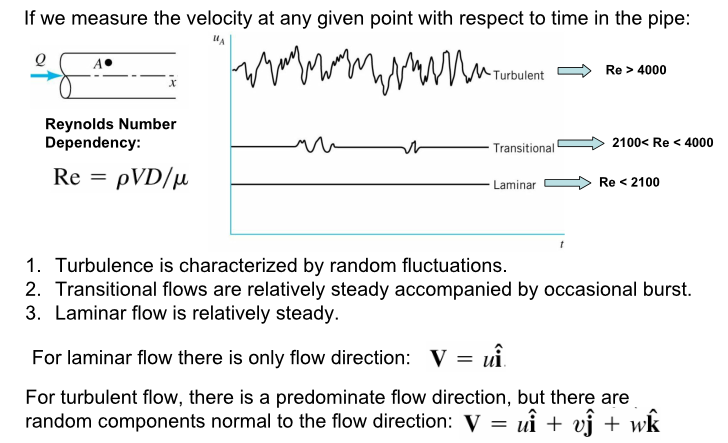
Re <2100——Laminar
2100≤ Re ≤4000——Transitional
Re >4000——Turbulent
但需注意:如果管道足够光滑,通过精心控制入口条件,可以在雷诺数很高的条件下,使流动仍然保持层流状态。
充分发展流 Fully Developed Flow
The fully developed steady flow in a pipe may be driven by gravity and /or pressure forces. If the pipe is held horizontal, gravity has no effect except for variation in hydrostatic pressure. The pressure difference between the two sections of the pipe, essentially drives the flow while the viscous effects provides the restraining force that exactly balances the pressure forces. This leads to the fluid moving with constant velocity (no acceleration) through the pipe. If the viscous forces are absent, then pressure will remain constant throughout except for hydrostatic variation.
管道中的流动,在重力或压力差的作用下可以发展为“充分发展流”(Fully Developed Flow)。如果管道水平放置,重力只会在竖直方向产生压力差(静水压力),对水平流动的影响可以忽略不计。横截面之间的压力差产生的驱动力导致流动,而流体粘性产生的阻力可以平衡该驱动力,流体就会以恒定的速度流动。如果没有粘性阻力,压力将会保持恒定(重力导致的静水压力除外)。
对于长管道中的流动,从入口均匀流入的流体,一旦进入管道,由于粘性的作用,管壁上的速度被迫降为零。而流量保持不变: 。
。
因此,管道中心区域流速大,靠近管壁的区域流速小,管壁上流速为零。这里的中心区域称为Inviscid core,该区域粘性的影响可以忽略不计。同一个横截面上,Inviscid core内各个位置速度一致。从管壁(流速为零)到Inviscid core之间的区域,称为边界层 Boundary Layer。边界层内,流体粘性的影响占主导地位。边界层的厚度,随流动方向逐渐增加。随着管道长度增加,边界层越来越靠近管道中心,最终合并在一起,这时Inviscid core完全消失,这样的状态称为:充分发展流 Fully Developed Flow。
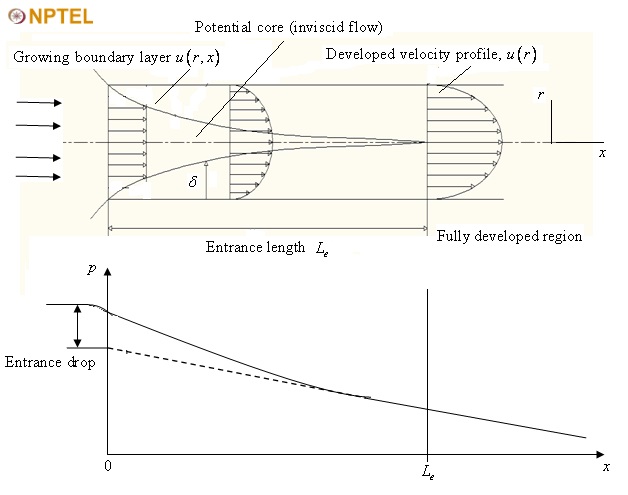
进口段长度 Entrance Length
The length of the pipe between the start and the point where the fully developed flow begins is called the Entrance Length.
从入口到充分发展流开始形成的位置,这段距离称为进口段长度 Entrance Length,记为Le,与雷诺数有关。一般规律如下:
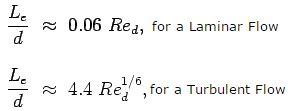
层流和湍流的剪切应力 Laminar and Turbulent Shear
层流状态,流动不存在随机波动。湍流状态,速度和压力随着空间和时间随机变化,可以用平均值+波动量来进行描述。
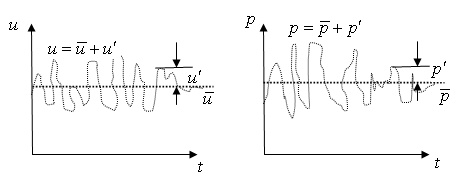
以速度u为例,湍流速度的平均值ū定义为:

其中,时间T应该足够长,远大于波动周期。速度波动量可以表示为:u'=u-ū。波动量的平均值 为零,但波动量的均方值
为零,但波动量的均方值 不为零。
不为零。

对波动量均方值 开根号,得到均方根,再除以湍流平均速度ū,就是湍流强度 Turbulence Intensity。
开根号,得到均方根,再除以湍流平均速度ū,就是湍流强度 Turbulence Intensity。

估算湍流强度 Estimating the turbulence intensity
When setting boundary conditions for a CFD simulation it is often necessary to estimate the turbulence intensity on the inlets. To do this accurately it is good to have some form of measurements or previous experince to base the estimate on. Here are a few examples of common estimations of the incoming turbulence intensity.
在CFD仿真中,通常需要设置入口处的湍流强度,最好是有测试数据或者以往的经验作为依据。这里将湍流强度分为高、中、低三档,可供参考.(来自CFD Online)
- High-turbulence case(高):High-speed flow inside complex geometries like heat-exchangers and flow inside rotating machinery (turbines and compressors). Typically the turbulence intensity is between 5% and 20%.
复杂几何模型(如热交换器)内的高速流动,旋转机械内的流动(涡轮、压缩机)。湍流强度一般在5%到20%之间。 - Medium-turbulence case(中):Flow in not-so-complex devices like large pipes, ventilation flows etc. or low speed flows(low Reynolds number). Typically the turbulence intensity is between 1% and 5%.
不那么复杂的几何模型(如大管道)内的流动,通风系统,低速流动(低雷诺数)。湍流强度一般在1%到5%之间。 - Low-turbulence case(低):Flow originating from a fluid that stands still, like external flow across cars, submarines and aircrafts. Very high-quality wind-tunnels can also reach really low turbulence levels. Typically the turbulence intensity is very low, well below 1%.
源头静止发展出来的流动(如汽车、潜艇、飞行器),高质量的风洞也可以获得湍流强度很低的流动。湍流强度小于1%.
在CFD仿真中,如何设定湍流条件?
对于K-ε和K-ω湍流模型,可以直接设定边界上K和ε(或ω)的值,也可以设置  (速度、特征长度和湍流强度),软件自动按照下面的公式进行计算:
(速度、特征长度和湍流强度),软件自动按照下面的公式进行计算:
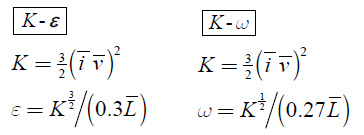
湍流速分布规律 Turbulent velocity profile
The typical measurements across a turbulent flow near the wall have three distinct zones. In the outer layer τtur is two or three orders of magnitude greater than τlam, and vice versa in the wall layer.
剪切应力τ由层流部分(τlam)和湍流部分(τtur)组成。根据这两部分所占的比例,可将流体近壁区域分为三层:Wall layer,Overlap layer 和 Outer layer。Outer layer中,湍流部分占主导;Wall layer中,层流部分占主导;Overlap layer介于Outer layer 和 Wall layer之间。
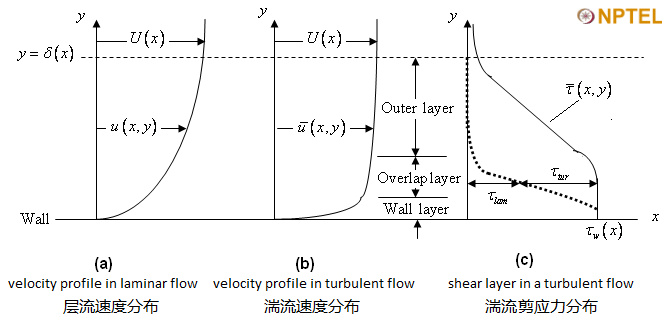
湍流的各层速度分布规律如下:
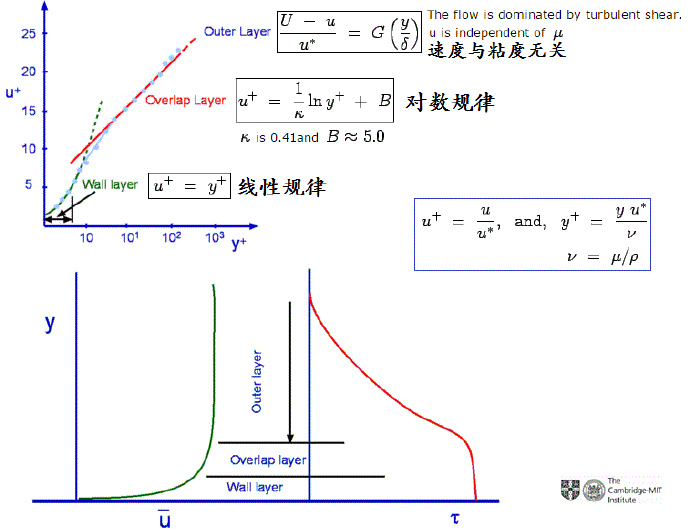
Reference: